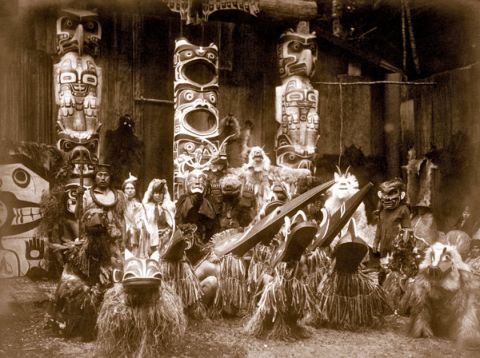 |
Canku Ota
|
 |
|
(Many Paths)
|
||
|
An Online Newsletter
Celebrating Native America
|
||
|
March 2015 - Volume
13 Number 3
|
||
|
|
||
|
'In The Land Of The
Head Hunters,' A Recreated Artifact Of Ancient Ways
|
||
|
by J. Hoberman - New
York Times
|
||
Around 1911, Edward S. Curtis (1868-1952), the celebrated photographer of Native Americans, began preparations for a six-reel feature about the Kwakwaka'wakw (formerly Kwakiutl) Indians of British Columbia. The movie, a commercial enterprise intended to underwrite the cost of Curtis's lavish photographic albums, was to be set before the arrival of European explorers and to feature a Kwakwaka'wakw cast. In addition to collecting masks and ceremonial objects, Curtis created a movie location off Vancouver Island, constructing false house-fronts, commissioning totem poles, and having wardrobes of cedar bark clothing woven. By organizing indigenous peoples to dramatize and thus conserve an ancestral way of life, Curtis's enterprise paralleled the "salvage paradigm" advocated by the anthropologist Franz Boas to rescue disappearing cultures. Curtis, who was perhaps the first to employ the term "documentary" with regard to film, also anticipated Robert Flaherty's 1922 portrait of the Inuits, "Nanook of the North." "In the Land of the Head Hunters" is the original ethnographic romance. The luridly titled narrative (supposedly based on oral tradition) is reminiscent of an Icelandic saga: Motana, the son of a Kwakwaka'wakw chief, embarks on a rite of initiation. He sees a young woman, Naida, in a dream and falls in love, only to discover that she has been promised to a local sorcerer; wresting her away from the older man, the newly minted warrior precipitates a violent feud between the clans. But "Head Hunters" is not so much a love story as a spectacle. Beginning with Motana's visit to the Island of the Dead, the movie lays out a feast of exotic imagery. One can only guess how the movie's original spectators responded when Curtis's "photodrama" was first shown at the Casino Theater on Broadway in 1914, accompanied by John J. Braham's original score. Appreciatively citing the movie's attractions ("whaling, sea lion hunting, dancing by Indians costumed as mythic animals and monsters, marriage, the sacking and burning of villages, sea fights between 80-man canoes"), The New York Times also noted a new photographic process by which "all the colors of the spectrum can be attained." Writing in Moving Picture World, W. Stephen Bush compared Curtis's movie with Wagnerian opera: "The fire-dance, the vigil journey with its command of silence and chastity, the whole character of the hero were most strangely reminiscent of 'Parsifal' and the 'Ring of the Nibelungs.' " Nevertheless, "Head Hunters" was a flop. Curtis sold his original negative, since lost, in the early 1920s. The few nitrate prints that existed were left to molder, although one, given to the Field Museum of Natural History in Chicago in 1947, formed the basis for "In the Land of the War Canoes," a 44-minute black-and-white re-edit, given a soundtrack and new intertitles, that was made in 1973 (and is included, along with other supplementary material, on the Milestone release). More partial prints were consequently discovered. These, along with original stills found in the Library of Congress, formed the basis for a fragile, hand-colored restoration made by the U.C.L.A. Film & Television Archive and the subsequent Milestone digitalization, which includes Braham's score. This, too, is a heroic tale. As Curtis used motion pictures to help preserve Kwakwaka'wakw life, so a tribe of archivists and historians applied their skills to approximate his approximation. His ambitious "salvage anthropology" has itself been salvaged. |
||
 |
|
|
||
|
|
||
| Canku Ota is a free Newsletter celebrating Native America, its traditions and accomplishments . We do not provide subscriber or visitor names to anyone. Some articles presented in Canku Ota may contain copyright material. We have received appropriate permissions for republishing any articles. Material appearing here is distributed without profit or monetary gain to those who have expressed an interest. This is in accordance with Title 17 U.S.C. Section 107. | ||
|
Canku Ota is a copyright ©
2000 - 2015 of Vicki Williams Barry and Paul Barry.
|
||
 |
 |
|
|
The "Canku
Ota - A Newsletter Celebrating Native America" web site and
its design is the
|
||
|
Copyright ©
1999 - 2015 of Paul C. Barry.
|
||
|
All Rights Reserved.
|
||
